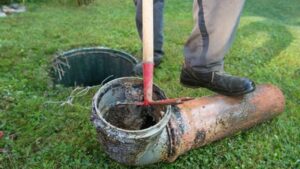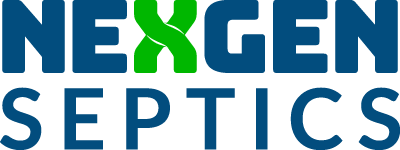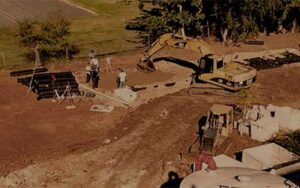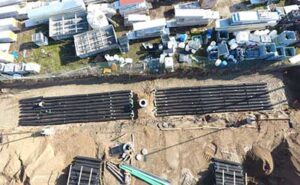Grading & Drainage Design
NexGen: Using Innovative Approaches to Engineering in Grading and Drainage Design

When NexGen produces a California grading and drainage design plan, we take the existing form of a piece of property and transform the contours, or the elevation lines, of the property. This controls how stormwater drains off the land. These new contours and drainage designs work with the proposed design, so the shape of the land fits the need of what has been planned.
NexGen wants rainwater runoff to flow away from buildings, walkways, roads, and parking lots into storm drains. This flow follows the swale, or direction of drainage. When looking at grading and drainage design plans, it is easy to look for an arrow, which indicates the swale. Water drainage is always at right angles to the contours. It will follow the steepest, or easiest, route downhill.
How Do I Read Contour Lines?
Contour lines on grading and drainage design plans are imaginary lines that show points of equal elevation. This elevation is relative to a known elevation, which is usually sea level, or 0’. When looking at the plan, NexGen indicates existing contours with dashed lines. All proposed contours are usually shown as solid lines and will connect to the existing contours. 5’ and 10’ contour elevations are often represented with a darker line.
When NexGen’s clients see a proposed contour, they know it shows the location of a change from the existing form of the land. If the proposed contour is a lower elevation than the existing contour, the earth is “cut” away. If the proposed contour is higher, this is referred to as “fill.” To make large level areas for parking lots and buildings, earth has to be cut or filled in. Sometimes, a little of both cutting and filling has to be done.
If our clients are looking at contours on a grading and drainage design plan, the contour elevation, or number indicating the contour’s height above sea level, is positioned on the high side of the contour. Contours that have a bend pointing uphill show a valley. If the contours are pointing downhill, they are indicating a ridge in the features of the land.
Sometimes NexGen indicates features on grading and drainage design plans that look similar to concentric circles. These are depressions or summits. A depression in the land is shown by contours with elevations decreasing as the contours move inward. If the contours decrease as they move outward, they show a summit.
What Are Spot Elevations?
When contours don’t show enough elevation information, or there is information about specific features between contours, NexGen uses spot elevations. A high point, for example, may need to be called out. Spot elevations look like an elevation with two decimal places beside what is typically an “X” shape, depending on the CAD standards used in the drawing.
What Is the Difference Between Profiles and Sections?
NexGen uses profiles and sections with grading and drainage design plans to show a perpendicular cross-section of an area on the drawing, like a road, for example. A profile shows the existing and the proposed grading and drainage features of the drawing. A section, on the other hand, shows only the proposed elements of the design.
NexGen uses the drainage features in their designs to remove water from surfaces of the development, including buildings, parking lots, and drives. A storm drainage system collects, carries, and disposes of runoff from precipitation events. Runoff is only around during and immediately after the rain. However, with more buildings (roofs), parking lots, and roads than ever, there is more runoff to contend with. All of this water needs to be removed every time it rains and has to drain away from buildings, walkways, and other paved areas.
How Does NexGen Manage Drainage Design Issues?
With grading and drainage design in California, one way of doing this is infiltration. Water is directed into beds and trenches that are in perforated pipes. The pipes are surrounded by coarse aggregate that is encapsulated by geotextile fabric. The water seeps into the earth. This is optimizing water resources through water recycling. Detention ponds work on the same principle.
NexGen also creates drainage design elements that move runoff by gravity onto landscaped surfaces where the runoff can be absorbed back into the earth. This is how drainage design may work in a single-family residential setting. The water flows off of the roof and into the house’s gutter. It goes down through the downspout and out into the yard, where it is absorbed or runs into a ditch. The runoff can flow down to the street. The water flows down the gutter until it falls into a catch basin and joins the rest of the rainwater runoff in the city’s stormwater management system.
In a private drainage system, the runoff comes off of the impermeable surfaces and follows the direction of drainage. It runs into a catch basin, or similar collection device placed at a low point. A storm drain system (of pipes) picks up the water at that point where gravity takes it on its journey (unless it encounters a pump station) until it is released in an appropriate area and manner.
NexGen – Creating Our Clients’ Grading and Drainage Design with the Cornerstones of Experience, Quality, and Safety
NexGen’s California grading and drainage design is an intricate process that keeps our clients’ developments safe from flooding and erosion. We protect them from the environmental waste that runoff can spread. With our almost thirty years’ experience in the construction and water treatment industries, we are achieving sustainability goals. NexGen can help you in rebuilding after disaster. We satisfy our clients with our commitment to exercising quality work and keeping everyone secure with consistently implemented safety practices.
Save 10% on All Septic Products
For All New Customers
"*" indicates required fields


